The Saree is worn by millions of Indian women and is, by far the most elegant. It is not merely an outfit but an ornament, lending both grace and glamour to the wearer. More important, the saree epitomizes the continuity of an age-old tradition that has withstood the onslaught of many different cultures, to emerge today as a visible symbol of the resiliency, continuity and timelessness of the Indian way of life
The saree speaks for itself of so many things. Every rustle of this unique garment has a story to tell – stories both of happiness and of sorrow. For the saree has seen it all. It has shared, with the wearer, every nuance of human experience – the joy and happiness of marriage, as well as the sorrow of parting, the pleasures and satisfaction of motherhood, the happy times when the life dealt kindly, the trying times when adversity was met with typical Indian stoicism.
The mood, the occasion, the event can all be conveyed through the saree. The colour reflects the occasion. The way it is draped signals the community. Brocades speak of happy times, an event of celebration – the birth of a baby, the marriage of a dear one. Festivals life Diwali or Durga Puja, are an occasion to bring out colourful dreams in gold weaved in-between vibrant rainbow-hued skeins of silk. Solemn white speaks of death, of the parting of a loved one. For those in the immediate family, it indicates a state of mourning and for those who come to offer condolences, it is a sign of their empathy with the bereaved. For the bride it is always, in almost all communities, a bright red.
So interwoven is the saree with the life and traditions of the people that each region of the country has developed a weave of its own. Each is a unique expression of the skills of the weavers and dyers, which have been handed down the generations. The exquisite patola weave, and the bandhini style of dyeing comes from the west. Weaving silks in vibrant colours, some weighing as much as 10 kilograms is a speciality of south India. Silk sarees embroidered with the kantha stitch, a speciality of the Bengal region in the east, is a typical example of the perseverance of the Indian craftsman. He puts in as much as six months of labour to create a single saree. The paithani silk saree from Maharashtra and the brocades from Benaras are equally representative of the continuation of the age-old crafts.
Then again, each region displays a different style of draping the saree. This is shaped by lifestyle and religious inclination.
The urban Indian style is by far the one most commonly seen. Stiff tangails, flowing silks, elegant chiffons and heavy brocades – all of them can be easily manoeuvred into this style. Tied around the waist, the saree forms a skirt with the pleats positioned in front thus allowing for free movement. The pallav or the part draped over the left shoulder is either pleated and pinned up the convenience, or is left flowing loose for glamour.
Tucked away in the mountains, in the south is Coorg, undoubtedly one of the most beautiful spots in India. Here, beauty stares at you in many forms – vast acres in myriad shades of green, little houses with red roofs enjoying the mountain air, orange blossoms lining the streets. It is the land of cardamom and coffee, of oranges and cashew, of brave generals and happy people.
The women here wear the saree in a style so unique, that its very elegance is intriguing. The pleats of the saree are not in front but at the back forming a fan. The pallav covering the chest is brought over the right shoulder. This is held in place with a broach or a pin, as they walk, the pleats behind gently swing giving the impression of the long train, lending grace and elegance to the already exceedingly beautiful women of this land.
The Bengalis of eastern India are tradition bound. Their lifestyle is simple, their intellect volatile yet deeply rooted in their culture. Every facet of their way of life reflects a seasoned refinement. This state boasts of, among other things, very independent women.
They are exceedingly active, yet fiercely traditional. This is perhaps best reflected in the fact that at festival time, come what may, all Bengali women make it a point to drape their saree in the Bengali way. Here there are no pleats. The saree is wrapped around the waist and tucked in at the left. This is then brought back to the right side and draped over the left shoulder. The portion left over is brought up under the right arm and draped once again over the left shoulder. The bunch of keys usually tied to the end of the pallav, jingle merrily as they walk, giving the women a traditional air.
Deep in the south is the style of Tamil Nadu, a repository of India’s ancient fine arts, dance and music. Protected by the hills, this region enjoyed long years of peace which not only nurtured the arts, but also developed a religious fervour that can still be seen among its people. The followers of the Hindu religion were divided into two distinct groups. Those who worshipped Lord Shiva came to be known as lyers and the worshippers of Lord Vishnu were as lyengars. So distinct were these two groups that they differed even in the way the women draped the tradition saree.
In both communities it was the extra long saree that was worn. This measured nine yards instead of the ordinary six yards. The draping of the saree in this style is rather complicated and perhaps needs to be explained step by step. After the first wrapping around the waist, the saree is brought back and pleated with the pleats positioned along the left leg. The rest of the saree is draped over the left shoulder, wrapped once again round the waist and tucked on the left side.
However the lyer style includes a few pleats at the back which is not there in the lyengar style. It is not very often that one sees women dressed in such sarees today. The style is by far, too cumbersome for the modern women. But at weddings this is a must, and so it is perhaps only once in a life time that the Brahmin women of Tamil Nadu wear the saree in this style. What is more, the enterprising clothiers have now introduced ready-to-wear nine yard sarees, all complete with hooks and buttons, offering a welcome alternative to trendy young girls!
In maharashtra, in the west, one finds a somewhat similar style. Here again the traditional saree nine long. It is worn in a similar fashion as found in Tamil Nadu. Tied around the waist it forms a loose trouser giving greater freedom of movement. The pleats are in front with the pallav falling over the right shoulder, giving full scope to exhibit the beautifully woven borders of the traditional Maharasthra saree.
To the north of the state of Maharastthra is the state of Gujrat, which has given India greater men, none less than the stature of Mahatma Gandhi. The typical patola weave in vibrant silks and earthy cottons are worn by the women of Gujrat in a style quite similar to the urban Indian one. The only difference is that the pallav is brought over the right shoulder and tucked across in front on the left side.
Bihar in the east is the home of the Santhal tribals, perhaps best known for their inherent sense of music. The saree as worn by these tribal women is quite different. Tied around the waist, the saree reaches upto the kness. The pallav is draped in the normal way around the left shoulder and then tucked in at the waist making for easy movement through the forests.
Thus the saree has survived along the length and breadth of the subcontinent. Perhaps this is because of the variety it offers. This seemingly cumbersome garment is in reality an extremely versatile, meaningful and adaptable one. It suits every possible occasion, every possible activity. Washing and cleaning, carrying firewood back from the forest in the anchal (pallav) or walking long distances can all be easily executed in a saree.
That is not all, the advantage of the saree are many more. The most important, fact is that it never goes out of fashion. At the most there may be phases when women prefer particular colours or when narrow borders are more in vogue than broad ones. But that is as far as it goes. It does not necessitate in any way the discarding of the saree.
Besides, the saree is universal. Grandmother and grand daughter can both carry off the same saree with equal grace. It moulds itself easily to every circumstance. No matter, how convenient, other Indian costumes may be, it is extremely unlikely that any women will give up wearing saree.
The history of Indian civilisation reveals that unstitched fabric has been the fulcrum for its apparel development. Saree along with dhoti, lungi, dupatta and so on falls under this category. The reason for this has been attributed to the belief that such a fabric is pure.

There have been some misinterpretations of the garment, its origin, and other such ilk. Some people attributed the garment to be a straight lift from a Greek or Roman toga one sees on medieval statues. That is not correct, since the garment is cent-per-cent an Indian one, and originated from the compulsions of sub-continent weather conditions. Saree is manufactured from a crop called cotton. This crop existed in India much before Greek legend Alexander, or for that matter any invader set foot on Indian soil. That in addition, centuries back of the same. The other interesting titbits worth a reveal are:
In the early stages, people of both sexes wore the garment. It became more refined, adjustable and in tune with the gender needs of men and women. This was necessitated by various considerations such as region and social conditions. With passage of time, the garment came to be known as dhoti and made in tune with the physical appearance of men folk. And the same with women, for whom the garment’s name remained the same, that is, Saree.
Early examples of Indian art support the existence of Saree. Scriptures from the Gandharva, Mathura and Gupta schools (1st-6thcentury AD) reveal that the Saree in its earlier form was a brief garment with a veil.
Ancient records also support the fact that in South India the Saree has been for a long period a single piece of material, which served as both skirt and veil. This trend continues to date in some rural areas.
The well-known Indian painter of the 19thcentury Raja Raviverma in his time was asked to do a neat paint-up on various goddesses. Towards this purpose, he looked for a wear, which suited the goddesses he was to paint. He scouted the length and breadth of the whole sub-continent for that elusive perfect female-wear. He found one, in the form of Saree, a garment that in his opinion made for a perfect female wear. It fitted and presented a woman, as they should be.
Famous Indian historical heroines like Queen Jhansi Laxmibai, Belawadi Mallamma and Kittur Chennamma wore Saree during their battles. Neat and tightly away, Saree enabled them to battle enemy troops on horseback.
A worn-out Saree was and is used in many innovative ways. Once its usefulness as a garment wears tapers off, they were and continue to be used as a bed sheet cover; the torn part of the garment was covered by a cloth and used as such. Village women use Saree as pouches and bags to carry grocery and their little ones. On some occasions, they are used by village folk as a cradle, tying the ends of a Saree to nearby trees.
They are also used as towels, napkins, and so on long after they are worn out. Ancient western historians like Herodotus and so on thought that Saree were cloth-growing trees in India.
India is a country of many costumes and dresses. Yet saree remains one of the most widely accepted garment across the country. For a six (sometimes nine) yard rectangular piece of cloth, a saree is very versatile and comfortable piece of clothing. A saree can make a woman of any age or shape look stunning. Its sheer simplicity, practicality and the hint of sensuousness makes it a hit with a major population of women in India.
Sarees come in endless varieties. They can be categories on the basis of their fabric or embroidery or print etc. There are a number of known types of sarees in India. Here are a few that are hugely popular:
Chikan
Chikan is basically an embroidery style from Lucknow, UP. Chikan is believed to have been introduced by Nur Jehan, Mughal emperor Jahangir’s wife. Traditionally chikan work meant white on white embroidery but today white threads are used on various color muslin cloth.
Benares Brocade
These are highly sought after variety of sarees. These are historically known to be one of the finest sarees in India and are known for their gold and silver brocade work, fine silk and rich embroidery. These are decorated with elaborate engravings and are thus very heavy.
Tant

The tant cotton sarees are best suited for hot and humid weather. These typically have elaborate pallus and broad gold threadwork borders.
Jamdani
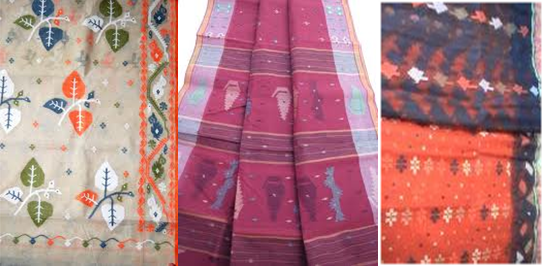
Jamdani sarees usually have very transparent but fine texture cloth resembling muslin. These display elaborate and ornate workmanship. These are preferred for office wear. Peacocks are a favourite motif as are vines and flowers.
A specific variety of Jamadani saree called Daccai, is woven painstakingly by hand on the old fashioned Jala loom, and many take even up to one year to weave a single sari.
Kantha
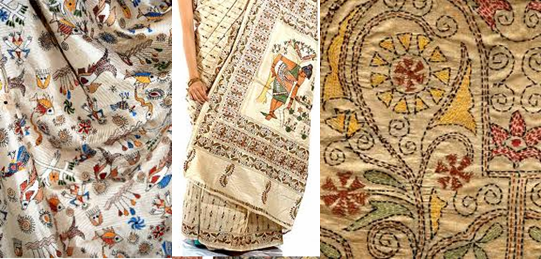
Kantha is a type of embroidery popular in Bangladesh and in West Bengal, India. Kantha sarees are known for its delicate thread embroidery.
Baluchari
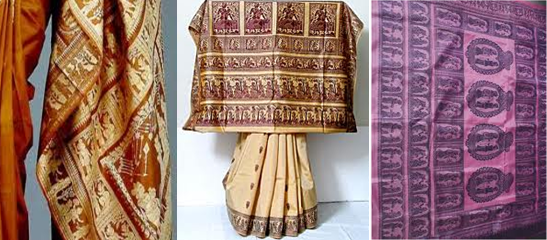
The Baluchari sarees are figured silk saree produced in the town of Baluchar in Murshidabad district of West Bengal. Baluchar sarees essentially have a silk base and avoid strong contrasts. These have detailed scenes from religious epics of India depicted on them and also other figures like horse with a rider, women smoking hookah and court scenes.
Ikat Saree
Ikat is a near universal weaving style common to many world cultures. Likely, it is one of the oldest forms of textile decoration. Ikat, or Ikkat, is the method of weaving that uses a resist dyeing process similar to tie-dye. ikat sarees typically have heavy threadwork borders and pallus with geometric ikat patterning.
Chanderi

The chanderi sarees are seen as the most sophisticated variety of sarees. These are produced in Chanderi town of Madhya Pradesh. These are generally plain, light and highly translucent sarees with golden borders and small booties all over.
Venkatgiri
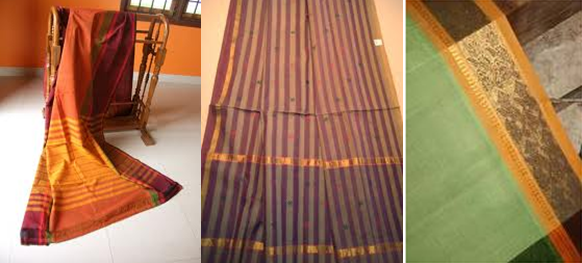
Venkatagiri town in Andhra Pradesh is famous for its Jari cotton sarees. The fabric is popular for its softness and durability. The sarees are suitable for all climates.
Gadwal
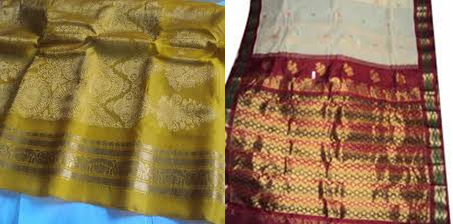
These are a mix of cotton and silk. There is complicated joinery involved and this gives the silk/cotton mix sari its charm. But its so popular because it is possible to fold a 5.5 meter Gadwal saree to the size of a match box.
Kanchipuram/ Kanjivaram
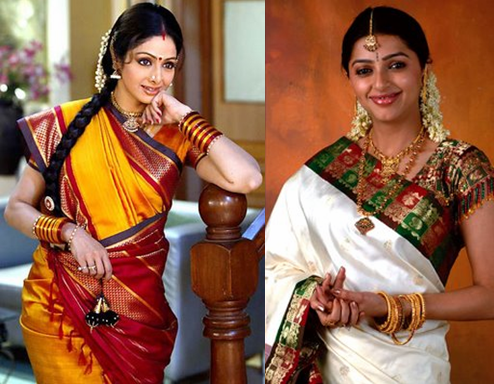
Kanchipuram town in Tamil Nadu is also known as Silk City since the main profession of the people living in and around is weaving silk sarees, more than 5,000 families are engaged in this industry. Kanchipuram or Kanjivaram sarees are richly brocaded silk sarees with broad borders of zari and striped pallus.
Paithani

Paithani variety of sari is named after the Paithan region in Maharashtra. These are hand woven, fine silk sarees. Colourful flowers are the typical motifs. They are considered the richest sarees in Maharashtra.
Bandhani
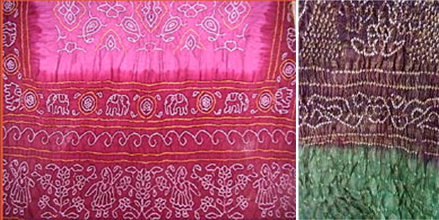
Bandhani, also known as Bandhej, is a type of tie-dye practiced mainly in the states of Rajasthan and Gujarat. After the processing is over, results into a variety of symbols including, dots, squares, waves and stripes. Bandani sarees are made in bright and contrasting colour combinations.
Indian silk has been popular the world over - for its sheer variety of designs, weaving and quality. This is largely due to the fact that India has the unique distinction of producing different varieties of silk.
There are four main varieties of silk produced by a distinct variety of silkworm feeding on a specific host plant. Silk is a protien fibre, produced by the silkworm for spinning around its cocoon. This fibre (filament) is unwound to obtain silk. Yarn is produced by twisting the fibre, which is then dyed, warped and finally woven to produce fabric.
Silk weavers in India have contributed to the development and fame of Indian silk. Across the length and breadth of the country, generations of weavers continue to create magic giving their creations a distinct touch - through the use of colours and designs.
Here are some traditional "types" of Indian silk available at Rasi.
The glamour of the Kancheepuram silk saree lies in its colour contrasts. Pyramidical temple borders, checks, stripes and floral "buttas" are traditional designs you will find in a Kancheepuram saree. In a genuine Kancheepuram saree, the border, body and pallav are woven separately and then interlocked together. The joint is woven so strongly that even if the saree tears, the pallav (or border) will not detach.

Found in Gujrat and Rajasthan, Bandhni is produced through an ancient method called "bandhej" or tie and dye. Designs are created on natural colour cloth by tightly winding thread around certain areas. The cloth is then dipped in dye. The thread is removed and the areas covered by the thread retain their original colour. Hence the name "tie & dye". Multiple colour designs are created by repeating this process.
Ikkat (also known as patola in Orissa) is also created using the tie & dye method. The difference is that the method is applied to the yarn prior to weaving - and hence a far more complex procedure. There are two - one where the method is applied to the warp only, and the other where it is done on both the warp and weft. In the latter, the fabric can be used on either side. Andhra Pradesh, Gujrat and Orissa are the main centers for this kind of work.
This is a method of weaving unique to Benaras - silk fabric is woven to create a raised effect (brocade). These sarees do not have a border, however the pallav is distinctly different. Traditionally, the designs are created using floral motifs.
Whether you're buying a saree or fabric, here are some tips on what to look for when buying silk.
- When you consider the fact that it takes three weavers approximately 7 to 10 days to weave one saree (46" X 168"), it is not surprising that silk is expensive. Watch out for "throwaway" priced silk - it's unlikely to be the real thing.
- Check the weight - the heavier the silk, the longer it will last.
- If there is zari work, ask if the zari is pure. Imitation zari will turn black in a couple of years. Incidentally, "pure gold" zari is a misnomer - it is not gold thread but has at its core a silk thread over which silver wire is twisted and then dipped in gold.
- The best way of checking for the purity of silk is to take a few threads and burn them. Pure silk will coagulate and leave a black powdery residue - not to be confused with ash. You will also find a faintly unpleasant odour.
- Of-course, your best bet always will be to buy silk from a reliable and established outlet.
Contrary to popular belief, good silk is not difficult to maintain. Caring for silk is simple - and if done properly, will last for years! Here's how -
- The best way of washing silk is the tried and tested traditional way. Just squeeze a few drops of lime in cold water. Dip the silk and rub gently, remove, wring lightly and dry away from direct sunlight.
- If using soap, make sure it's mild. Use cold water and do not soak silk in soap water. Dip, rub gently, rinse and dry in the shade.
- Avoid the use of chemicals - these may damage your silk, and end up reducing its life considerably.








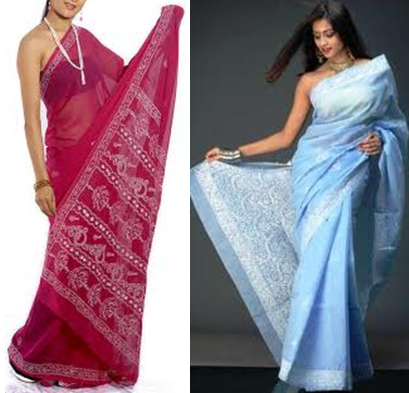

No comments:
Post a Comment